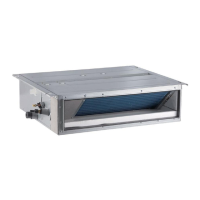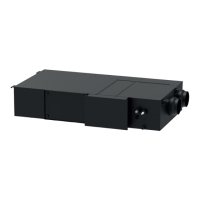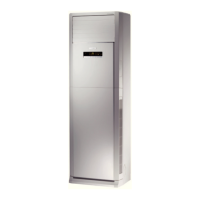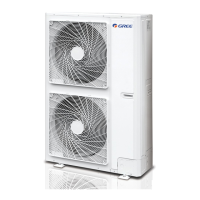Why does my Gree GMV emit an odor?
- CcgonzalesSep 12, 2025
If your Gree Air Conditioner emits an odor, it's possible that the unit is blowing out room odors that it has absorbed. Unfortunately, the provided manual extract does not offer a solution.

Why does my Gree GMV emit an odor?
If your Gree Air Conditioner emits an odor, it's possible that the unit is blowing out room odors that it has absorbed. Unfortunately, the provided manual extract does not offer a solution.
What happens when there is a mode conflict in Gree Air Conditioner?
When the indoor operating mode conflicts with that of the outdoor unit, the indoor fault indicator will flash and a conflict will be shown on the wired controller after 5 minutes. The indoor unit stops running, and the system changes the outdoor operating mode to match the indoor unit. After this adjustment, the unit should return to normal operation. Note that COOL mode does not conflict with DRY mode, and FAN mode does not conflict with any mode.
Why doesn't the indoor fan start during heating in my Gree Air Conditioner?
The indoor unit (IDU) fan may not start immediately during heating. This is because the fan is designed to wait until the heat exchange becomes hot to prevent delivering cool air. Also, during defrosting, the IDU fan may stop because the system switches to cooling mode to prevent delivering cool air. The fan will resume operating after defrosting. In both cases, allow the system time to complete its process.
| Type | Variable Refrigerant Flow (VRF) |
|---|---|
| Compressor Type | Inverter Scroll Compressor |
| Refrigerant | R410A |
| Energy Efficiency | High Efficiency |
| Control | Centralized control, individual control |
| Operating Temperature Range (Heating) | 24°C |
| Noise Level (Indoor Unit) | 19 - 45 dB(A) |
Explains safety alert symbols (WARNING, CAUTION, NOTICE) and general safety rules.
Lists critical safety instructions for unit operation and installation.
Details the GMV DC Inverter VRF system and its features.
Shows possible combinations of single and multiple outdoor units.
Details ODU models and their maximum connectable IDU units.
Specifies the operational temperature limits for cooling and heating.
Lists the standard parts supplied with the outdoor unit.
Provides diagrams for required space around single, dual, and three-module units.
Details required clearances for three-module outdoor unit installations.
Specifies clearances required above the outdoor unit based on obstructions.
Shows required clearances for multi-module outdoor unit configurations.
Guidance on installing units considering seasonal wind direction.
Advice on installing units to prevent snow accumulation issues.
Specifies pipe diameter and wall thickness for R410A systems.
Details requirements for the concrete foundation of the outdoor unit.
Shows outline dimensions and mounting hole details for specific models.
Provides physical dimensions for GMV-96WM, GMV-120WM, and GMV-144WM models.
Details the physical dimensions for the GMV-168WM/B1-F(U) model.
Illustrates the layout of refrigerant piping for the system.
Shows piping sequences for different outdoor unit models.
Diagrams and guidelines for connecting multiple outdoor units.
Defines limits for pipe length and height differences between units.
Specifies pipe length differences and adjustment tables.
Details pipe sizes for connecting outdoor units to the first manifold.
Specifies pipe sizes between manifolds based on upstream module capacity.
Details pipe sizes from ODU to the first indoor manifold.
Specifies pipe sizes for connections between indoor manifolds.
Details pipe sizes for connections between indoor units and manifolds.
Guidance on selecting manifolds based on downstream indoor unit capacity.
Describes Y-type and T-type manifold installation methods and positions.
Key safety and installation guidelines for connecting refrigerant pipes.
Specifies fixing points for Y-type manifolds and layout requirements.
Instructions for insulating refrigerant pipes for efficiency and safety.
Steps for removing air and moisture from the refrigerant system.
Guides on calculating and adding refrigerant based on system configuration.
Safety measures and concentration limits to prevent hazards from refrigerant leaks.
General safety rules and considerations for electrical wiring.
Details on power cord sizing, protection, and connection requirements.
Step-by-step instructions for connecting the external power cord.
Describes the communication network between ODU, IDU, and controllers.
Explains different communication modes and connection methods.
Illustrates correct and incorrect wiring methods for communication lines.
Details auto-addressing technology and manual settings for controllers.
Graphics showing how to connect IDUs and ODUs for communication.
Illustrates various ways to connect wired controllers to IDUs.
Describes how to connect duct type IDUs to light board receivers.
Diagrams for connecting central control systems to VRF units.
Shows the wiring diagram for a single outdoor and indoor unit setup.
Illustrates wiring diagrams for modular outdoor and indoor unit configurations.
Checklist of items to verify after installation before trial run.
Guidance on preparing for and executing the trial run.
Important notices and conditions for performing the trial run.
Details the sequence and meaning of LED indicators during debugging.
Further explanation of LED indicators and error codes during debugging.
Describes direct and PC-based debugging methods and steps.
Details manual confirmation steps for modules and IDUs during setup.
Covers internal communication and outdoor component checks during debugging.
Checks for indoor components and compressor preheating status.
Evaluates refrigerant levels and outdoor valve status before startup.
Confirms startup readiness and selects cooling/heating mode.
Indicates when debugging is finished and the system enters standby.
Provides reference values for judging normal operation of system parameters.
Continues the table of reference values for system parameters.
Lists common issues, their reasons, and suggested measures for resolution.
Describes normal operating sounds or conditions that may seem like malfunctions.
Lists error codes and their corresponding malfunctions for indoor units.
Lists error codes and their corresponding malfunctions for outdoor units.
Continues the list of error codes for outdoor units.
Lists error codes specific to the debugging process.
Instructions for cleaning the outdoor unit's heat exchanger.
Guidance on checking and cleaning the condensate drain pipe.
Pre-seasonal checks to ensure readiness for operation.
Tasks to perform after the unit has been out of use.
Information on purchasing and replacing unit parts.
Conditions that must be met for the unit's warranty to remain valid.











